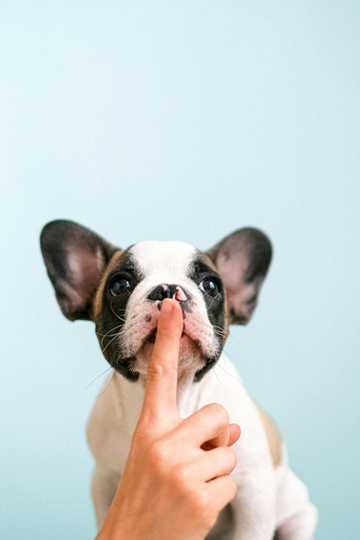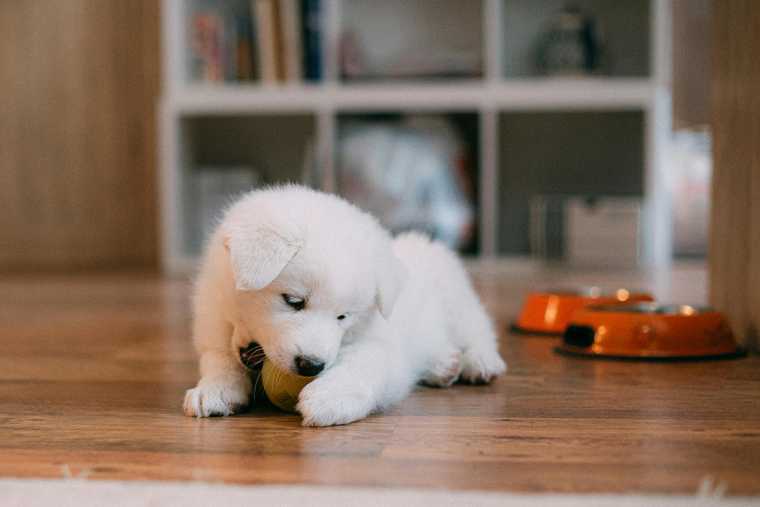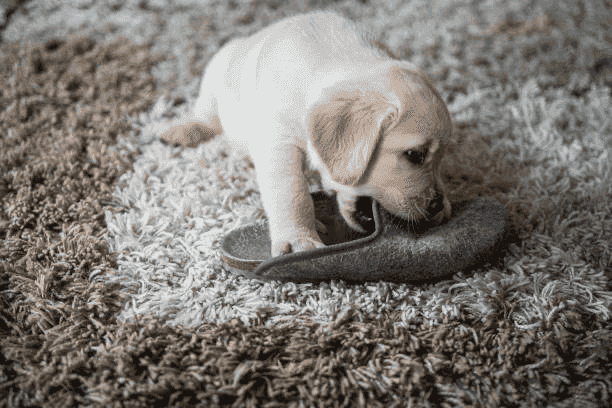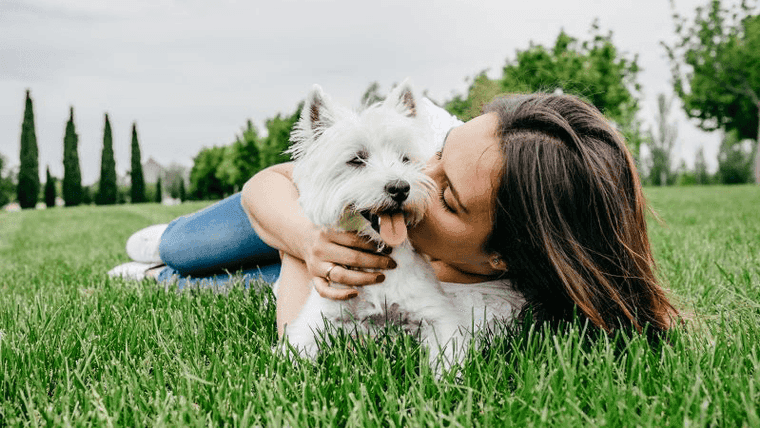How to Get Your Puppy to Stop Biting in 7 Steps

Ever wonder how your cute little puppy could be such a handful? Your new pet is so playful, so curious, and oh-so-sweet! But... How can they bite so hard?
In this article, you’ll find an 7-step guide on how to save yourself and your favourite slippers from the cute little disaster running around spreading bites of joy by learning how to train your puppy not to bite.
There is always more to learn about the psychology behind your pet’s behavior. Try the Woofz app for more fun facts, educational content, and professional advice.
Why Do Puppies Bite?
Biting is their natural speaking skill. They bite to communicate their needs, to learn, and to play. Like their owners, dogs can feel stressed and scared at times. And don’t forget, they’re still growing, so they bite when they’re teething, too.
What’s even more surprising is that they will also bite to show affection. But what if that’s not exactly your love language?
The good news is dogs are incredibly smart. You can direct and fulfill their nipping needs without getting hurt.
Playful Mouthing vs. Aggression
Remember, biting is a normal part of your puppy’s development and doesn’t mean that something is wrong. But how exactly do you know it’s not a sign of aggression?
A playful puppy has a relaxed body and face. They don’t show any sign of tension. In case of a temper tantrum, their body looks stiff or frozen. They’re likely to show their teeth and growl. The aggressive bites are more painful. If your puppy starts to throw a temper tantrum, stay calm and cool. If you’re holding your puppy, let them go. If you keep holding them, they might start showing aggressive behavior as a sign of fear. And it’s only going to escalate the longer you hold them.

They might even bite the next time you try to hold them. It’s better to let them go and try to understand what made your little doggy so restless. They might have been hurt or scared of something. Don’t yell to show you’re hurt. Don’t hurt them.
Stay calm until they stop struggling. If it happens repeatedly, make sure to contact a trained professional for personalized guidance.
How To Stop A Puppy From Biting in 8 Steps
Step 1: Allow gentle nibbling
The first thing you want to teach your puppy is to understand the limit of how hard they can press against your skin before it hurts. Allow gentle nibbling, but when it gets painful, make a loud sound and let your hand lie still. A high-pitched “Ow!” will teach them where the limits are. Be patient and consistent. We’re also going to talk about ways to redirect their biting energy to a chewy toy or give them a time-out after biting.
When puppies are raised by their mothers, they learn their limits at an early age of about 3 weeks. When the demanding newborn wants to nurse, whenever they feel like it, their mother starts to rebuff some of their efforts. If they nip hard, they get physically punished.
If hard biting takes place while playing, their playmates cry and stop playing with them. Of course, this is not supposed to encourage you to discipline your puppy when they misbehave physically. But remember that your baby dog has to learn some manners. Educate them with love and patience.

Step 2: Teach a puppy not to bite by offering them their favorite treat
Continue with this technique and slowly reduce the strength of the bite that makes you go “Ow!”. Then, slowly teach them that mouth and skin don’t belong together. You can do this by training your puppy with their favorite treats. Hold a cookie in your closed hand, and only open it when no mouthing or chewing is happening. Give your smart fluffy friend enough time and enough cookies to adapt to the new rule!
Step 3: Let them play
Now, they’re starting to get the idea that your arms and legs are no toys. They understand your limbs are off-limits. But what about your slippers?

Fun Fact: Did you know that a dog’s nose is at least 100,000 times more sensitive than ours? That makes footwear the most fascinating smell-filled toy for a dog.
There are a lot of different puppy-safe toys. You can get a soft rubber toy or a stuffed fabric toy with a squeaker inside. Figuring out what toys excite them will help you train your puppy not to bite. Encourage your puppy to play by showing them lots of different toys. Find out which your puppy likes the most.
Pets have their preferences, too. Learn what can make your four-legged friend truly happy and leave your slippers where they belong.
If your puppy is teething, get them a special toy that will ease sore gums. They are made with softer plastic.
Step 4: Provide plenty of exercise
Daily walks and mental stimulation can help reduce mouthing and biting. Make sure to provide plenty of opportunities for your little one to play with other friendly, vaccinated dog buddies. Socializing is important for your puppy’s development. On top of that, if they burn off that energy in the most natural way, they will feel less motivated to play roughly with you afterward. That’s how you can get a puppy to stop biting and chill a bit. Doesn’t the idea of just relaxing with your puppy sound exciting?
Pro Tip: Provide frozen foods every day (e.g., carrots, apples, bananas) as ice is anti-inflammatory, and it’ll relieve teething pain.
Step 5: Give them some “Me” time
So you keep training your dog not to bite, but sometimes they don’t seem to focus? Learning has never been easy. If your puppy is having a hard time focusing on the subject, give them time to play alone and calm down. Let them twirl and chase that tail as much as they need. Let them chew that toy. Let them have some “Me” time and get back to training when they seem more ready for it.
If walking away for a while doesn’t seem to help, you can learn more about helping your reactive dog calm down.
Step 6: Train your puppy not to bite your ankles
Does your puppy show special interest in your ankles? Certain breeds of dogs have strong herding instincts. Whenever your new pet bites your ankles to “keep the herd moving,” just stand still and hang in there. In no time, they’ll understand that nipping your ankles has the opposite effect. They bite, and you freeze.
As you’re teaching your puppy not to bite, it could also be a good idea to carry their favorite toy in your pocket. Whenever they attack your ankles, stop moving and take out the toy and wave it enticingly. If your pup keeps repeating this behavior even when you offer the toy, you should give them a time-out (lock them in an appropriate space with no toys, no fun, just for a few minutes).
Don’t forget to praise your puppy. With enough patience, they’ll get used to seeing you move without chasing your feet. You won’t have to drag a fluffy thing attached to your pants around the house anymore.
Step 7: Enroll in a puppy class
Sign up for a puppy obedience class. This can be a great way to learn positive reinforcement training techniques and socialize your puppy. Don’t know which to choose?
Join Woofz’s “Say Goodbye to Problem Behaviors” training program developed by a certified dog trainer!
Bonus Tips On How To Teach A Puppy Not To Bite
Most importantly, stay patient and focused. Be an understanding and loving friend for your pet. Praise them for small achievements. Never shout, and never, ever physically punish your puppy. Verbal and physical corrections won’t teach your puppy how to behave. Negative reinforcement might only teach them to suppress their emotions or defend themselves.
If you use punishment to train your puppy, they can grow into a fearful, anxious, and even aggressive dog. You don’t want them to get back at you by completely ruining your favorite slippers, do you? That’s exactly what we’re trying to avoid here.

Final Thoughts
Great! Now you know how to deal with your bitey pup. Your newly trained puppy will have an easy time making new dog friends. Who knows, they might even make it easier for you to make a few human friends, too. With good training and treatment, your puppy will reward you by being your most devoted and loving friend. The connection will be unbreakable and “unbiteable.”
Written by

Woofz Content Manager with a deep passion for dogs and a strong affinity for positive reinforcement training methods.
Reviewed by

Certified dog trainer, exclusive positive reinforcement methods & tackling aggression problems.